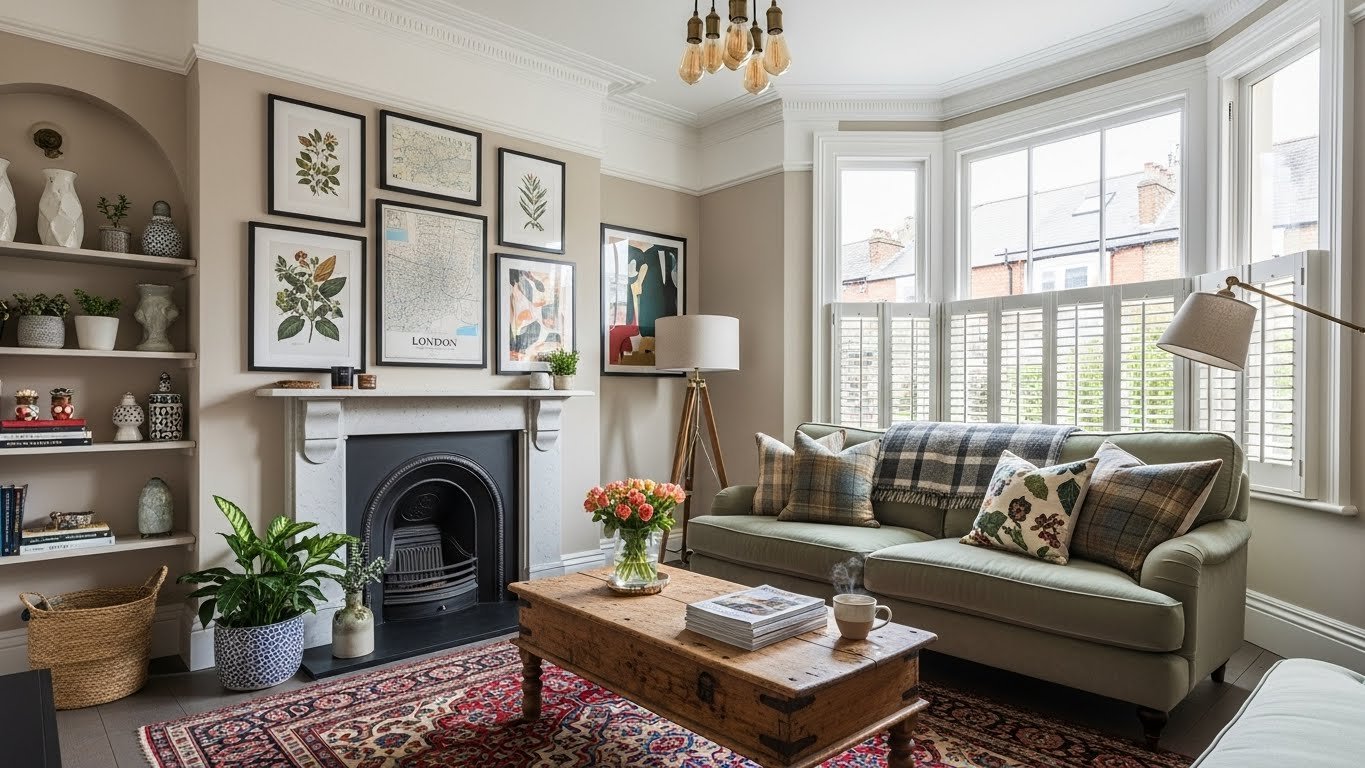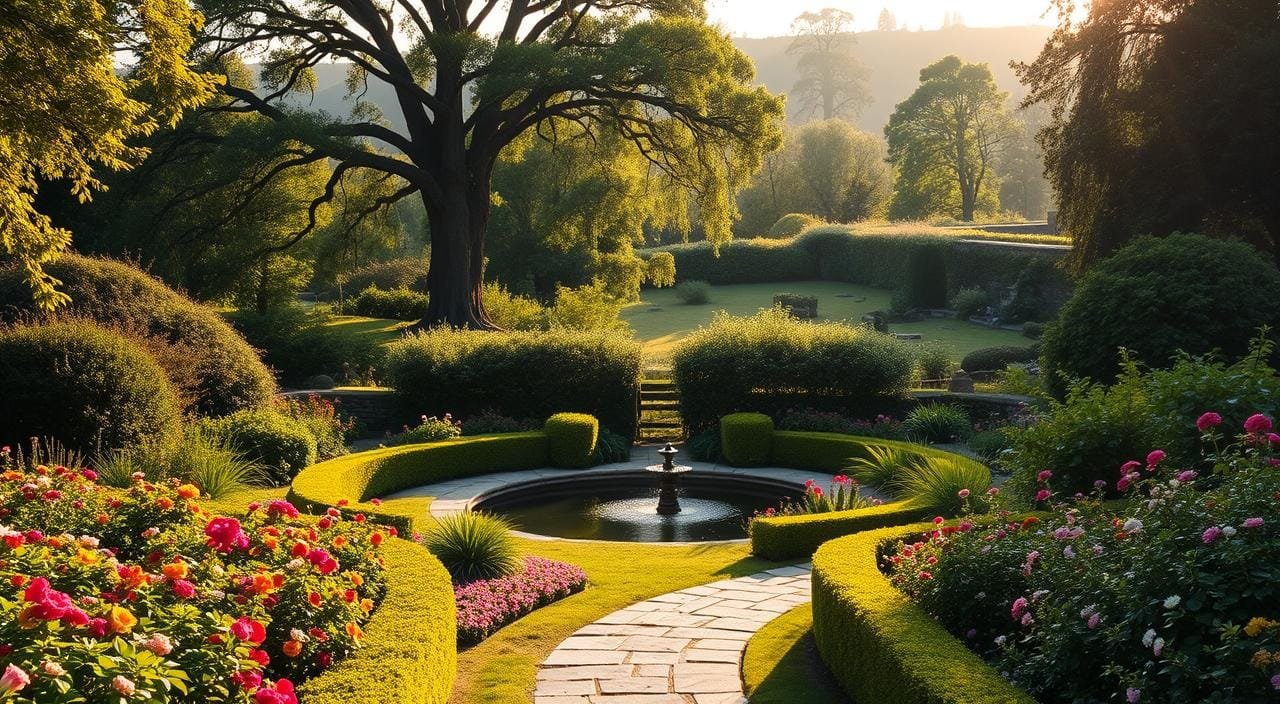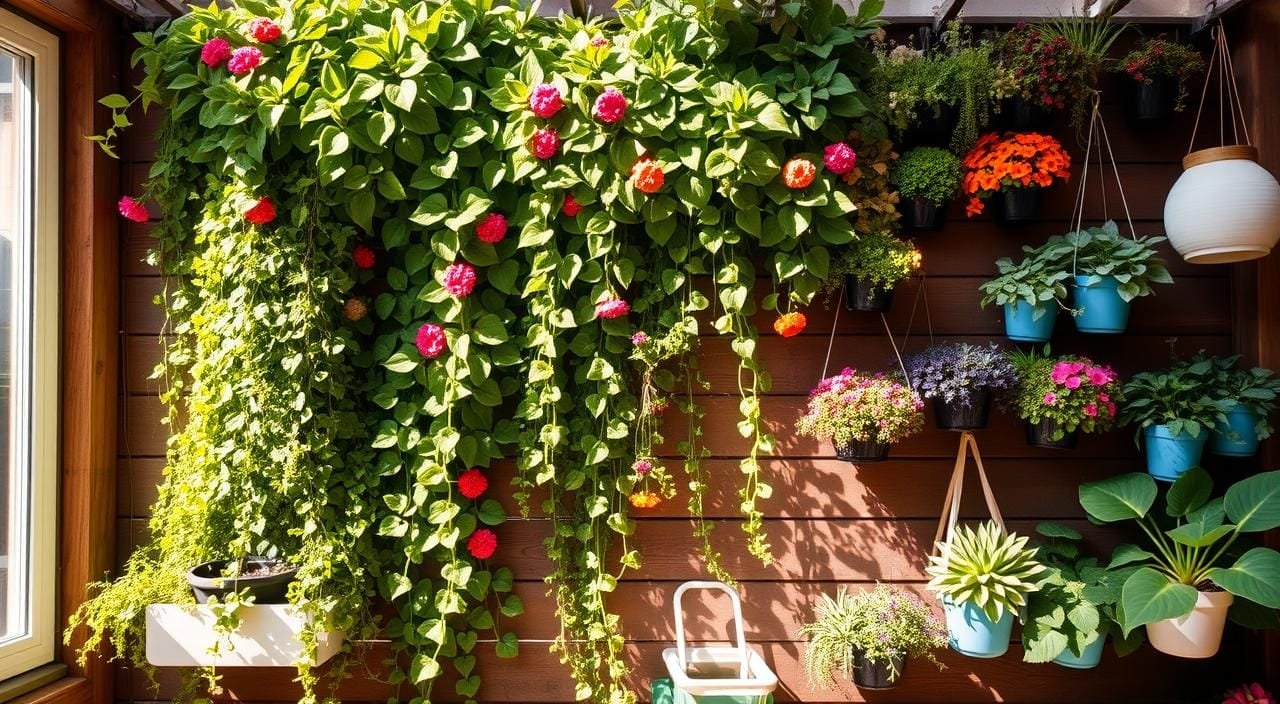Turning your outdoor area into a calm oasis is simpler than you might think. By adding essential elements of a peaceful retreat, you can make a space that encourages relaxation and balance.
Picture stepping into your backyard and feeling a deep calm, surrounded by nature’s beauty. A well-designed outdoor sanctuary can be a refuge from daily stress. To create this, knowing the key parts of a serene and welcoming space is important.
By the end of this article, you’ll know how to design and keep a beautiful outdoor area. It will bring balance and harmony to your life, using zen garden ideas that fit your style.
The Philosophy Behind Zen Gardens
Zen gardens are more than just beautiful spaces. They are deeply rooted in philosophical thought. Understanding this philosophy can make you appreciate their design more. It also helps you create a Zen garden with deeper meaning.
Origins and History of Japanese Zen Gardens
Zen gardens started in Japan, influenced by Buddhist and Shinto philosophies. They were made in temples and monasteries for meditation and contemplation. The history of Zen gardens is tied to Zen Buddhism, focusing on mindfulness and the bond between nature and humans.
Symbolism and Meaning in Zen Garden Design
Every part of a Zen garden has a special meaning. Rocks and stones stand for mountains and islands. Gravel or sand represents the sea or emptiness. The placement of these elements aims to bring harmony and balance, inviting visitors to meditate.
By understanding these symbols, you can appreciate the thought behind Zen gardens. You can also add meaningful zen garden ideas to your own design. This way, your garden can reflect your style and help you connect with nature and find inner peace.
Understanding the Purpose of Your Zen Garden
Starting your Zen garden journey? Knowing its purpose is key for a meaningful design. A Zen garden can improve your outdoor area in many ways.
Meditation and Contemplation Space
A Zen garden’s main goal is to offer a calm spot for meditation and contemplation. With smooth stones, gravel, and special plants, you can make a peaceful place. This space encourages mindfulness.
Visual Beauty and Aesthetic Appeal
Your Zen garden can also add beauty to your outdoor space, bringing visual beauty and aesthetic appeal. With careful design and natural elements, it becomes a beautiful centerpiece.
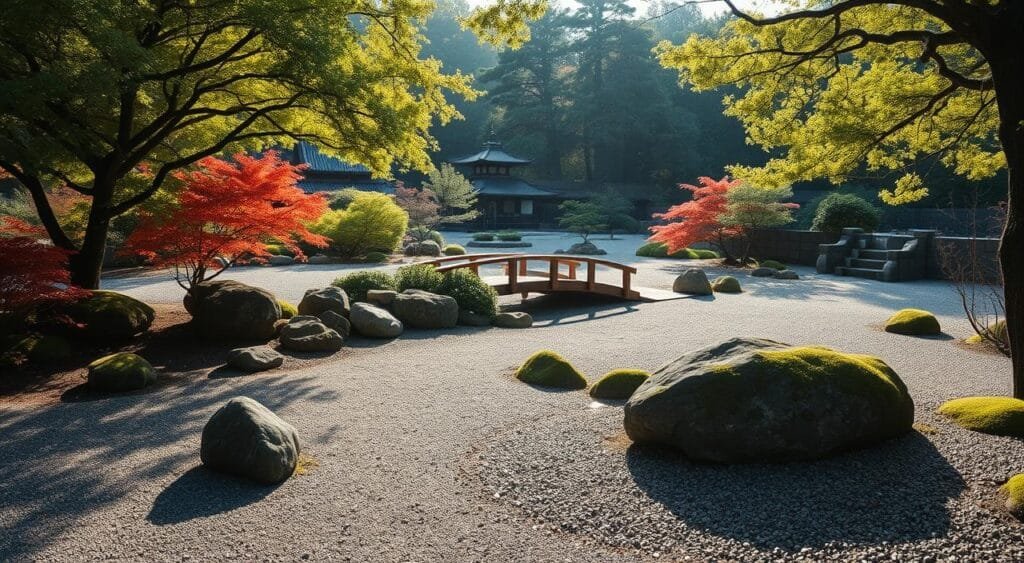
Creating Balance in Your Outdoor Environment
A well-made Zen garden can balance your outdoor area, making it a peaceful part of your home. By planning the layout and choosing elements, you can bring calm to your backyard.
Planning Your Zen Garden Project
Starting a Zen garden project requires a good plan. We’ll show you how to plan your Zen garden, using zen garden ideas to make it serene.
Assessing Your Available Space
First, look at the area for your Zen garden. Think about its size, shape, and what’s already there. Consider how to make it a peaceful spot. Note the sunlight and shade, as they affect your plant and design choices.
Setting a Realistic Budget
Decide how much you can spend on your Zen garden. A budget helps you choose materials, plants, and features. Remember to include costs for tools or professional help. A good budget keeps your project on track.
Creating a Design Blueprint
Now, plan your design with your space and budget in mind. Sketch out your ideas, thinking about where to put stones, plants, and water features. You can use paper or digital tools for your blueprint.
Hand-Drawn vs. Digital Planning Tools
Hand-drawn plans offer a personal touch, while digital tools are flexible and easy to change. Pick what suits your project best.
Seasonal Considerations in Your Design
Think about how your Zen garden will change with the seasons. Choose plants and features that look good all year. This makes your garden beautiful in every season.
With careful planning, you can create a serene and peaceful outdoor space. It will reflect your style and offer a calm retreat.
Essential Zen Garden Ideas for Your Backyard Sanctuary
Creating a Zen garden is a journey to serenity. With the right ideas, you can turn your backyard into a peaceful sanctuary. It’s more than a beautiful outdoor space; it’s for meditation, contemplation, and connecting with nature.
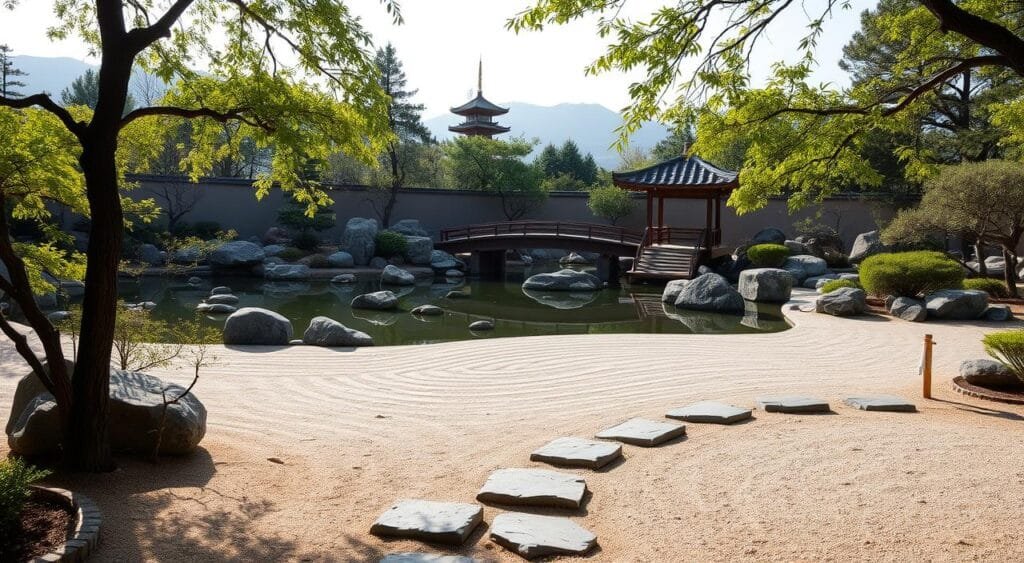
Minimalist Designs for Small Spaces
For those with limited space, a minimalist Zen garden design works well. Use a small stone lantern, a compact bonsai tree, and a raked gravel or sand area. These elements bring calm and serenity, even in small spaces.
Elaborate Layouts for Larger Areas
If you have more space, you can go for more elaborate Zen garden ideas. Add a small pond or water feature, meandering stone paths, and various plants and trees. The goal is to balance these elements harmoniously.
Indoor Zen Garden Options
You don’t need a backyard to have a Zen garden. Indoor Zen garden ideas include using a container or pot for a mini garden. Use small plants, rocks, and sand to create a serene atmosphere.
Adapting Traditional Elements for Modern Homes
You can also adapt traditional Zen garden elements for modern homes. Use modern materials for pathways and add contemporary art pieces that reflect Zen principles. The essence of Zen is simplicity and mindfulness, so feel free to innovate while staying true to these principles.
By using these Zen garden ideas, you can create a serene oasis. Whether you have a small balcony or a large backyard, there’s a Zen garden design for you.
Selecting and Preparing the Perfect Location
Finding the right spot for your Zen garden is key. The perfect location can make your zen garden ideas more serene and beautiful.
Considering Sun Exposure and Shade
Look at how much sun and shade your yard gets. Zen gardens need a mix of both for a peaceful feel.
Evaluating Existing Landscape Features
Check out your yard’s features like trees and slopes. Using these can make your Zen garden unique.
Creating Privacy and Seclusion
A Zen garden should feel private. Use natural barriers or fences to keep it secluded.
Ground Preparation Techniques
After picking a spot, get the ground ready. Level the soil and clear out debris. This makes a solid base for your garden.
With the right location and preparation, you can make a peaceful Zen garden. It will reflect your zen garden ideas perfectly.
Incorporating Rocks and Stones: The Foundation Elements
The strategic placement of rocks and stones is key in Zen garden design. It shapes the garden’s look and feel. Rocks and stones help create harmony and balance in your Zen garden.
Types of Rocks for Different Effects
Different rocks and stones can change the mood of your Zen garden. Granite rocks bring a rugged feel, while smooth river stones are calming. Choose rocks for their texture, color, and shape to get the mood you want.
Proper Placement and Arrangement Techniques
Placing rocks and stones is an art that needs thought. You must balance their visual weight for harmony. Let’s look at some ways to do this.
The Rule of Odd Numbers
Using odd numbers when arranging rocks makes your garden look better. For example, three or five rocks together can balance your garden.
Creating Visual Weight and Balance
Visual weight is how heavy or light something looks. In Zen gardens, balance comes from distributing this weight. Place big rocks at the bottom and small ones at the top or around the edges.
Building Stone Pathways and Borders
Stone pathways and borders are both useful and beautiful. Use flat stones for paths or to mark off areas. They guide visitors and make your garden feel like a journey.
By carefully choosing rocks and stones, you can make your Zen garden more peaceful. It becomes a place for calm thought and relaxation.
Sand and Gravel: Creating the Canvas of Your Zen Garden
Sand and gravel are key to your Zen garden’s beauty. They help create a peaceful space for reflection. These materials greatly impact your garden’s look and feel.
Selecting the Right Type of Sand or Gravel
Think about your garden’s design when picking between sand and gravel. Sand can look like water or make simple patterns. Gravel adds texture and variety. Choose colors and textures that match your garden’s other features.
Installation Methods and Best Practices
Installing sand or gravel right is important. First, clean and level the area. Next, put down a weed barrier. Then, spread the material evenly with a rake for a smooth finish.
Raking Patterns and Their Meanings
Raking patterns in your Zen garden have deep meanings. Simple lines can mean calmness. More complex designs might symbolize water or waves. Raking itself is a way to focus and be present.
Tools and Techniques for Creating Patterns
To make detailed patterns, you need the right tools. A wooden rake is traditional and works well. Try different raking styles to get the look you want. It’s about creating beauty and finding peace.
Water Features: Real and Symbolic Options
To make your Zen garden truly immersive, think about adding water features. These elements are key in traditional Zen gardens. They bring both visual and auditory peace.
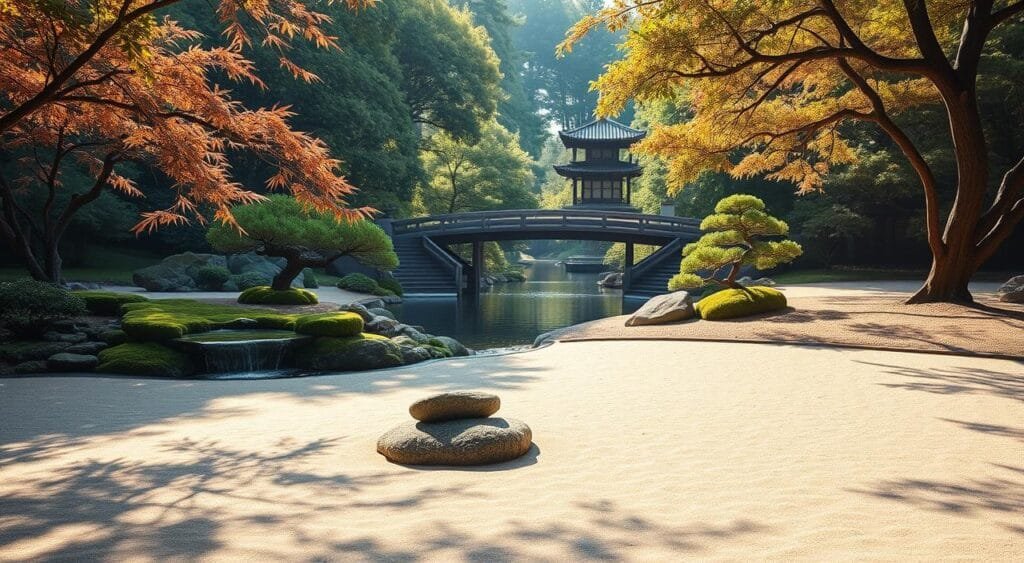
Traditional Water Basins (Tsukubai)
A tsukubai, or traditional water basin, is used for ritual cleansing before tea ceremonies. Adding a tsukubai to your Zen garden adds authenticity and spiritual depth.
Small Ponds and Streams
Small ponds and streams bring a calming, natural feel to your Zen garden. The sound of flowing water is calming and meditative.
Dry Water Features Using Stones and Gravel
If you prefer something easy to maintain or live in areas where water features are hard, use stones and gravel. Raking patterns in the gravel can create a serene, dynamic look.
Installation and Maintenance Considerations
When setting up a water feature, think about space, budget, and upkeep. Keeping it clean and well-maintained is key to your Zen garden’s tranquility.
Adding water features thoughtfully to your Zen garden design can greatly enhance its ambiance. It creates a peaceful retreat that reflects Zen principles.
Selecting and Arranging Plants for Harmony
Creating harmony in your Zen garden means picking and placing plants carefully. The right plants can make your garden a calm place for rest and thought. It’s a space for peace and balance.
Traditional Japanese Plants and Trees
Traditional Japanese plants and trees are key in Zen garden design. Moss, Japanese Maple, and Bamboo are favorites for their beauty and meaning. Moss brings calm with its greenery. Japanese Maple trees show the beauty of change, like life’s cycles.
Low-Maintenance Plant Options for Different Climates
Choosing plants that fit your local weather is important. For hot places, Succulents and Lavender are great. In cooler areas, Boxwood and Japanese Holly do well. These plants need little care and can handle local weather, keeping your garden peaceful all year.
Pruning and Training Techniques
Pruning and training keep your Zen garden plants healthy and looking good. Regular pruning controls size and shape. Training, like wiring branches, makes plants look unique and beautiful. These steps help your garden look its best and keep plants happy.
Container Plants vs. In-Ground Planting
Whether to use pots or plant directly in the ground depends on your style and plant needs. Pots are flexible and easy to move. Direct planting looks more natural. Both ways can make a Zen garden peaceful and balanced, based on your design and plant choices.
By picking and arranging plants wisely, you can make a Zen garden that’s full of harmony and balance. It becomes a peaceful place for rest and thought.
Decorative Elements and Final Touches
As you near the end of your Zen garden, it’s time to add the final touches. These elements are key to making your garden a peaceful oasis. They invite you to relax and think deeply.
Lanterns and Their Placement
Lanterns add light and beauty to Zen gardens. Place them along paths to welcome visitors. Choose from stone, metal, or paper lanterns to fit your garden’s look.
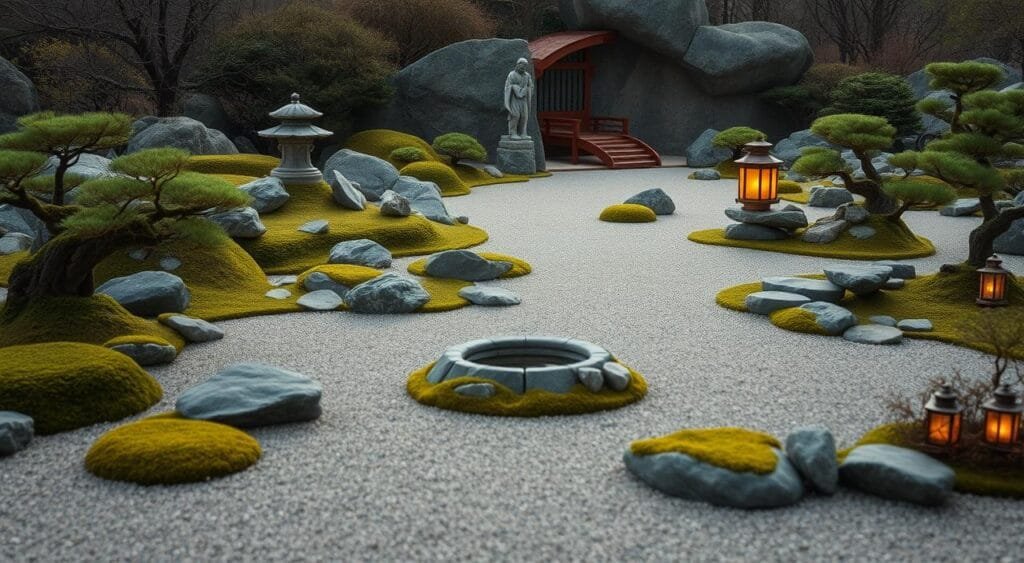
Bamboo Fences and Screens
Bamboo fences and screens bring a natural feel to your garden. They offer privacy and add interest. Use different bamboo types and heights to make it visually appealing.
Bridges and Stepping Stones
Bridges and stepping stones are more than just paths. They enhance your garden’s beauty. Pick materials like stone or wood that match your garden’s style.
Benches and Seating Areas
Benches and seating areas are perfect for sitting and thinking. Choose a bench that fits your garden’s look. Add cushions for extra comfort. Place them where you can enjoy a peaceful view.
With these decorative elements, your Zen garden will be a peaceful retreat. Look for zen garden ideas to make your outdoor space a sanctuary.
Conclusion: Maintaining Your Zen Garden Through the Seasons
As the seasons change, your Zen garden needs care to stay serene and beautiful. To keep your outdoor space peaceful, think about your zen garden ideas all year.
In spring, trim plants and refresh the gravel or sand for a clean look. Summer needs regular watering and maybe shade to protect from the sun.
Autumn is for removing leaves and pruning plants. Winter asks for covering plants and securing loose items to protect from harsh weather.
With these easy tips, you can enjoy your Zen garden all year. It will be a peaceful oasis. Adding these ideas to your seasonal care will keep your garden calm and serene.

